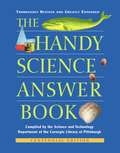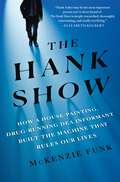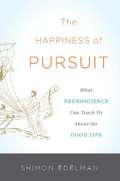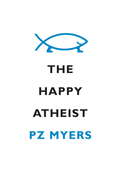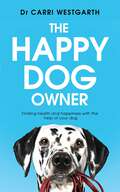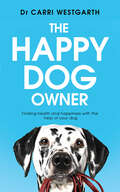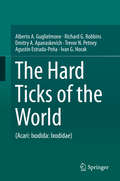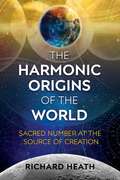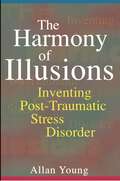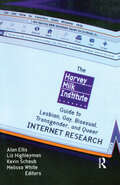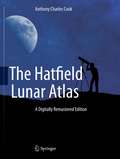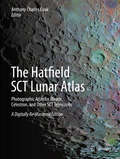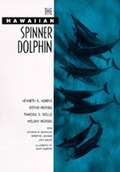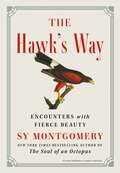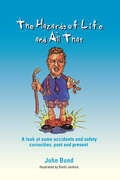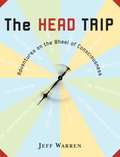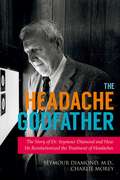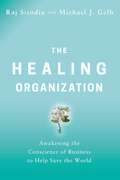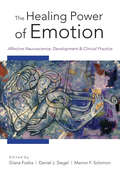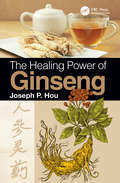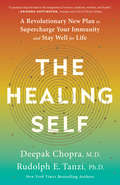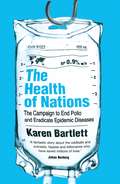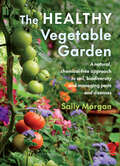- Table View
- List View
The Handy Science Answer Book
by The Carnegie Library of PittsburghPresenting a fun and educational way to explore the wonders of the world of science, this newly updated edition poses and answers 2,200 questions, providing an abundance of original and interesting science facts. Children and adults will uncover some of the most interesting, unusual, and quirky science curiosities such as: Are cell phones dangerous to your health? Is the same strain of yeast used to make different types of beer? What is the cleanest fossil fuel? What is the largest invertebrate? Readers will find this informative and enjoyable resource is chock full of hundreds of intriguing science and technology topics, from the inner workings of the human body and outer space to math, computers, planes, trains, and automobiles.
The Hank Show: How a House-Painting, Drug-Running DEA Informant Built the Machine That Rules Our Lives
by McKenzie FunkThe bizarre and captivating story of the most important person you've never heard of.The world we live in today, where everything is tracked by corporations and governments, originates with one manic, elusive, utterly unique man—as prone to bullying as he was to fits of surpassing generosity and surprising genius. His name was Hank Asher, and his life was a strange and spectacular show that changed the course of the future.In The Hank Show, critically acclaimed author and journalist McKenzie Funk relates Asher's stranger-than-fiction story—he careened from drug-running pilot to alleged CIA asset, only to be reborn as the pioneering computer programmer known as the father of data fusion. He was the multimillionaire whose creations now power a new reality where your every move is tracked by police departments, intelligence agencies, political parties, and financial firms alike. But his success was not without setbacks. He truly lived nine lives, on top of the world one minute, only to be forced out of the companies he founded and blamed for data breaches resulting in major lawsuits and market chaos.In the vein of the blockbuster movie Catch Me if You Can, this spellbinding work of narrative nonfiction propels you forward on a forty year journey of intrigue and innovation, from Colombia to the White House and from Silicon Valley to the 2016 Trump campaign, focusing a lens on the dark side of American business and its impact on the everyday fabric of our modern lives.
The Happiness of Pursuit: What Neuroscience Can Teach Us About the Good Life
by Shimon EdelmanWhen fishing for happiness, catch and release. Remember these seven words-they are the keys to being happy. So says Shimon Edelman, an expert on psychology and the mind. In The Happiness of Pursuit, Edelman offers a fundamental understanding of pleasure and joy via the brain. Using the concept of the mind as a computing device, he unpacks how the human brain is highly active, involved in patterned networks, and constantly learning from experience. As our brains predict the future through pursuit of experience, we are rewarded both in real time and in the long run. Essentially, as Edelman discovers, it’s the journey, rather than the destination, that matters. The idea that cognition is computation-the brain is a machine-is nothing new of course. But, as Edelman argues, the mind is actually a bundle of ongoing computations, essentially, the brain being one of many possible substrates that can support them. Edelman makes the case for these claims by constructing a conceptual toolbox that offers readers a glimpse of the computations underlying the mind’s faculties: perception, motivation and emotions, action, memory, thinking, social cognition, learning and language. It is this collection of tools that enables us to discover how and why happiness happens. An informative, accessible, and witty tour of the mind, The Happiness of Pursuit offers insights to a thorough understanding of what minds are, how they relate to each other and to the world, and how we can make the best of it all.
The Happy Atheist
by Pz Myers"I'm an atheist swimming in a sea of superstition, surrounded by well-meaning, good people with whom I share a culture and similar concerns, and there's only one thing I can do. I have to laugh." --PZ Myers Through his popular science blog, Pharyngula, PZ Myers has entertained millions of readers with his infectious love of evolutionary science and his equally infectious disdain for creationism, biblical literalism, intelligent design theory, and other products of godly illogic. In this funny and fearless book, Myers takes on the religious fanaticism of our times with the gleeful disrespect it deserves, skewering the apocalyptic fantasies, magical thinking, hypocrisies, and pseudoscientific theories advanced by religious fundamentalists of all stripes. With a healthy appreciation of the absurd, Myers not only pokes fun at the ridiculous tenets of popular religions but also highlights how the persistence of Stone Age superstitions can have dark consequences: interfering with our politics, slowing our scientific progress, and limiting freedom in our culture. Forceful and articulate, scathing and funny, The Happy Atheist is a reaffirmation of the revelatory power of humor and the truth-revealing powers of science and reason.
The Happy Dog Owner: Finding Health and Happiness with the Help of Your Dog
by Carri Westgarth'Carri Westgarth's unique combination of scholarship and practical experience with dogs will make this the go-to book for every enquiring dog owner' – Dr John Bradshaw, bestselling author of In Defence of DogsWhat if your dog could teach you a few new tricks for living a happier, healthier life?Drawing on her many years of research on human-animal interaction, Dr Carri Westgarth will help you to gain a new understanding of your dog's needs and how to be the best owner you can be. Learn to harness the power of your special bond with your pet and train your dog to be a canine alarm clock, cuddle on command and get you out and about more than ever before.Improve your pet's wellbeing with a wealth of science-led techniques and easy-to-learn tips – because a contented, well-behaved dog leads to a relaxed, healthy owner.You really can train your dog to train YOU to live a better life.
The Happy Dog Owner: Finding Health and Happiness with the Help of Your Dog
by Carri Westgarth'Carri Westgarth's unique combination of scholarship and practical experience with dogs will make this the go-to book for every enquiring dog owner' – Dr John Bradshaw, bestselling author of In Defence of DogsWhat if your dog could teach you a few new tricks for living a happier, healthier life?Drawing on her many years of research on human-animal interaction, Dr Carri Westgarth will help you to gain a new understanding of your dog's needs and how to be the best owner you can be. Learn to harness the power of your special bond with your pet and train your dog to be a canine alarm clock, cuddle on command and get you out and about more than ever before.Improve your pet's wellbeing with a wealth of science-led techniques and easy-to-learn tips – because a contented, well-behaved dog leads to a relaxed, healthy owner.You really can train your dog to train YOU to live a better life.
The Happy Dog Owner: Finding Health and Happiness with the Help of Your Dog
by Carri Westgarth'Carri Westgarth's unique combination of scholarship and practical experience with dogs will make this the go-to book for every enquiring dog owner' – Dr John Bradshaw, bestselling author of In Defence of DogsWhat if your dog could teach you a few new tricks for living a happier, healthier life?Drawing on her many years of research on human-animal interaction, Dr Carri Westgarth will help you to gain a new understanding of your dog's needs and how to be the best owner you can be. Learn to harness the power of your special bond with your pet and train your dog to be a canine alarm clock, cuddle on command and get you out and about more than ever before.Improve your pet's wellbeing with a wealth of science-led techniques and easy-to-learn tips – because a contented, well-behaved dog leads to a relaxed, healthy owner.You really can train your dog to train YOU to live a better life.
The Hard Ticks of the World
by Agustín Estrada-Peña Alberto A. Guglielmone Richard G. Robbins Dmitry A. Apanaskevich Trevor N. Petney Ivan G. HorakThis book has been designed to summarize current, essential information for every one of the world's 700+ hard tick species. Under each species name, we will cite the original description, followed by information on type depositories, known stages, distribution (by zoogeographic region and ecoregion), hosts, and human infestation (if any). Each species account will also include a list of salient references and, where necessary, remarks on systematic status. We envision eight chapters: six devoted to the major ixodid tick genera (Amblyomma, Dermacentor, Haemaphysalis, Hyalomma, Ixodes, Rhipicephalus), one covering eight minor genera (including two that are fossil), and a concluding summary chapter. There will be two tables on host associations and zoogeography in each major genus chapter, as well as five tables in the summary chapter, for a total of 17 tables. No similar synopsis of the world's hard tick species exists in any language.
The Harmonic Origins of the World: Sacred Number at the Source of Creation
by Richard HeathA profound exploration of the simple numerical ratios that underlie our solar system, its musical harmony, and our earliest religious beliefs • Reveals how the orbits of Jupiter, Saturn, and Uranus relate to the Moon and the inner planets as an octave with musical scales • Explores how this harmonic planetary knowledge was encoded within ancient monuments and temples then spread within oral traditions • Explains how the solar system functions as a musical instrument and how this led to the rise of intelligent life, civilization, and culture on our planet As modern humans first walked the Earth roughly 70,000 years ago, the Moon’s orbit came into harmonic resonance with the outer planets of Jupiter, Saturn, and Uranus. The common denominators underlying these harmonic relationships are the earliest prime numbers of the Fibonacci series--two, three, and five--the same numbers that interact to give us the harmonic relationships of music. Exploring the simple mathematical relationships that underlie the cycles of the solar system and the music of Earth, Richard Heath reveals how Neolithic astronomers discovered these ratios using megalithic monuments like Stonehenge and the Carnac stones, discoveries that informed later myths and stories including the Epic of Gilgamesh, the Resurrection of Osiris, the Rg Veda, the Hebrew Bible, Homer’s epic tales, and the Return of Quetzalcoatl. He explains how this harmonic planetary knowledge formed the basis of the earliest religious systems, in which planets were seen as gods, and shows how they spread through Sumer, Egypt, and India into Babylon, Judea, Mexico, and archaic Greece. He exposes how the secret knowledge encoded within the Bible’s god YHWH was lost as Greek logic and reason steadily weakened mythological beliefs. Revealing the mysteries of the octave and of our musical scales, Heath shows how the orbits of the outer and inner planets gave a structure to time, which our Moon’s orbit could then turn into a harmonic matrix. He explains how planetary time came to function as a finely tuned musical instrument, leading to the rise of intelligent life on our planet. He demonstrates how this harmonic science of numbers can be read in the secret symbolism and sacred geometry of ancient cities such as Teotihuacan and in temples such as the Parthenon, connecting the higher worlds of planetary time and harmonics with the spiritual and physical life on Earth. Recasting our understanding of the solar system, Heath seeks to reawaken humanity’s understanding of how sacred numbers structure reality, offering an opportunity to recover this lost harmonic doctrine and reclaim our intended role in the outer life of our planet.
The Harmony of Illusions: Inventing Post-Traumatic Stress Disorder
by Allan YoungAs far back as we know, there have been individuals incapacitated by memories that have filled them with sadness and remorse, fright and horror, or a sense of irreparable loss. Only recently, however, have people tormented with such recollections been diagnosed as suffering from "post-traumatic stress disorder." Here Allan Young traces this malady, particularly as it is suffered by Vietnam veterans, to its beginnings in the emergence of ideas about the unconscious mind and to earlier manifestations of traumatic memory like shell shock or traumatic hysteria. In Young's view, PTSD is not a timeless or universal phenomenon newly discovered. Rather, it is a "harmony of illusions," a cultural product gradually put together by the practices, technologies, and narratives with which it is diagnosed, studied, and treated and by the various interests, institutions, and moral arguments mobilizing these efforts. This book is part history and part ethnography, and it includes a detailed account of everyday life in the treatment of Vietnam veterans with PTSD. To illustrate his points, Young presents a number of fascinating transcripts of the group therapy and diagnostic sessions that he observed firsthand over a period of two years. Through his comments and the transcripts themselves, the reader becomes familiar with the individual hospital personnel and clients and their struggle to make sense of life after a tragic war. One observes that everyone on the unit is heavily invested in the PTSD diagnosis: boundaries between therapist and patient are as unclear as were the distinctions between victim and victimizer in the jungles of Southeast Asia.
The Harvey Milk Institute Guide to Lesbian, Gay, Bisexual, Transgender, and Queer Internet Research
by Alan L Ellis Melissa White Kevin SchaubFind the facts, figures, and connections you need on the Internet!This powerful reference tool is the most comprehensive, reliable guide to Internet resources for the LBGTQ community. More than just a guide to useful Web sites, it also evaluates LGBTQ mailing lists, message boards, search engines, and portals.The Harvey Milk Institute Guide to Lesbian, Gay, Bisexual, Transgender, and Queer Internet Research provides background information as well as useful URLs. It covers the history and objectives of major sites. The in-depth interviews with leaders of the queer Internet include discussions with Barry Harrison, Director of Queer Arts Resources, and Sister Mary Elizabeth, founder of AEGiS.The Harvey Milk Institute Guide to Lesbian, Gay, Bisexual, Transgender, and Queer Internet Research includes resources for a variety of academic disciplines, including:the humanitiesthe social scienceslawlabor studiesmedia studiestransgender and intersex studiesand more!Edited by Alan L. Ellis, co-chair of the institute's board of directors, The Harvey Milk Institute Guide to Lesbian, Gay, Bisexual, Transgender, and Queer Internet Research is an indispensable tool for researchers, community leaders, and scholars.
The Hatfield Lunar Atlas
by Anthony Cook"The Hatfield Lunar Atlas" has become an amateur lunar observer's bible since it was first published in 1968. A major update of the atlas was made in 1998, using the same wonderful photographs that Commander Henry Hatfield made with his purpose-built 12-inch (300 mm) telescope, but bringing the lunar nomenclature up to date and changing the units from Imperial to S.I. metric This edition is important since the fact is that modern telescope optics, digital imaging equipment and computer enhancement can easily surpass what was achieved with Henry Hatfield's 12-inch telescope and a film camera. This limits the usefulness of the original atlas to visual observing or imaging rather small amateur telescopes. The new, digitally re-mastered edition vastly improves the clarity and definition of the original photographs - significantly beyond the resolution limits of the photographic grains present in earlier atlas versions - while preserving the layout and style of the original publications. This has been achieved by merging computer-visualized Earth-based views of the lunar surface, derived from NASA's Lunar Reconnaissance Orbiter data, with scanned copies of Commander Hatfield's photographic plates, using the author's own software. The results is a "The Hatfield Lunar Atlas" for 21st century amateur telescopes up to and beyond 12-inch aperture.
The Hatfield SCT Lunar Atlas
by Anthony Charles CookIn 2004, it became obvious that Henry Hatfield's original atlas wasn't suitable for all current commercially-made amateur telescopes. Newtonian telescopes and astronomical refractors - for many years the only choice for amateurs - invert the observed image. The standard Hatfield Atlas therefore follows the IAU (International Astronomical Union) convention of having maps (and photographs) with South at the top and West on the left: an inverted image. However, the current ranges of Schmidt-Cassegrain and Maksutov telescopes - that's most of those manufactured by Meade, Celestron, and many others - don't invert the observed image but instead reverse it left-for-right. That's with North at the top and East on the left. Because of the way the human visual system works, it is almost impossible to mentally 'mirror-image' a map to compare it with the view through the eyepiece , so even turning an IAU-standard atlas upside-down doesn't help! This new SCT version of the Atlas solves this problem for observers. Identification of lunar features is made quick and easy. The new, digitally re-mastered second edition vastly improves the clarity and definition of the original photographs - significantly beyond the resolution limits of the photographic grains present in earlier atlas versions - whilst preserving the layout and style of the original publications. This has been achieved by merging computer-visualized Earth-based views of the lunar surface, derived from NASA's Lunar Reconnaissance Orbiter data, with scanned copies of Commander Hatfield's photographic plates, using the author's own software. The result is a The Hatfield SCT Lunar Atlas for 21st century amateur telescopes up to and beyond 12-inch aperture. It contains all the features that made the original so widely used: a combination of an index of all International Astronomical Union named primary lunar features, and twelve chart areas help to locate any named lunar features of interest that can each be examined under typically five different states of illumination. Close ups of interesting features are also included. The new Atlas is supplemented by an introduction to its use, a short description of the digital re-mastering technique, and a completely new section describing lunar observing techniques. At the end of the atlas there is an index of all named features and crater diameters, along with a summary table of the dates and times that the original Hatfield images represent.
The Hawaiian Spinner Dolphin
by Kenneth S. Norris Melany Würsig Shannon M. Brownlee Christine M. Johnson Jody Solow Bernd Würsig Randall S. WellsThis absorbing book is the first comprehensive scientific natural history of a dolphin species ever written. From their research camp at Kealake'akua Bay in Hawaii, the authors followed a population of wild spinner dolphins for more than twenty years. They observed marked animals by ship, by air, from a cliffside observation post, by radiotracking their movements, and by studying the details of their underwater social life with the use of a windowed underwater vessel. Beginning with a description of the spinner dolphin species, including its morphology and systematics, the book examines the ocean environment and organization of dolphin populations and the way this school-based society of mammals uses shorelines for rest and instruction of the young. An analysis of the dolphins' reproductive patterns, which resemble those of other group-dwelling mammals such as certain primates, suggests a fission-fusion society. Vision, vocalization, hearing, breathing, feeding, predation, integration of the school, and school movement are all examined to give the fullest picture yet published of dolphin biological life. One of the most striking features of the species is the length of the period of juvenility and instruction of the young. The authors argue that dolphins may legitimately be called "cultural," and they turn in their conclusion to a comprehensive evolutionary analysis of this marine cultural system with its behavioral flexibility and high levels of cooperation. In a challenging new interpretation of how cultural organisms may evolve, they propose that spinner dolphin society be viewed as a set of nested levels of organization that influence one another by selectional biases. The resulting cooperative patterns support both the sociology and the cultural levels of organization, without being overridden by the supposed imperative of kin selection. Twenty years in the making by a renowned scientist and his associates, this absorbing book is the richest source available of new scientific insights about the lives of wild dolphins and how their societies evolved at sea.
The Hawk's Way: Encounters with Fierce Beauty
by Sy MontgomeryA splendid and luminous celebration of one of nature&’s most perfect and mysterious creatures—the hawk—from the New York Times bestselling author of the &“astoundingly beautiful&” (NPR) The Soul of an Octopus. When Sy Montgomery went to spend a day at falconer Nancy Cowan&’s farm, home to a dozen magnificent birds of prey, it was the start of a deep love affair. Nancy allowed her to work with Jazz, a feisty, four-year-old, female Harris&’s hawk with a wingspan of more than four feet. Not a pet, Jazz was a fierce predator with talons that could pierce skin and bone and yet, she was willing to work with a human to hunt. From the first moment Jazz swept down from a tree and landed on Sy&’s leather gloved fist, Sy fell under the hawk&’s magnetic spell. Over the next few years, Sy spent more time with these magnificent creatures, getting to know their extraordinary abilities and instincts. They are deeply emotional animals, quick to show anger and frustration, and can hold a grudge for years. But they are also loyal and intensely aware of their surroundings. In this mesmerizing account, featuring sixteen pages of gorgeous color photographs, Sy passionately and vividly reveals the wonderous world of hawks and what they can teach us about nature, life, and love.
The Hazards of Life and All That: A look at some accidents and safety curiosities, past and present, Third Edition
by J BondA light-hearted look at an extremely serious subject, The Hazards of Life and All That: A Look at Some Accidents and Safety Curiosities, Past and Present, Third Edition presents numerous examples of accidents throughout history and around the world, drawn from a wide range of contemporary sources. Illustrated with high-quality cartoons, this historical anthology addresses important issues affecting humans while presenting them in a humorous, accessible style. The author relates anecdotes from the gentleman struck, even in death, by lightning to the ICI invention of WATER, a cheap resource for quenching fires. The anecdotes contain salutary reminders on the precautions one should take to secure a long and healthy life.
The Head Trip: Adventures on the Wheel of Consciousness
by Jeff WarrenA world at once familiar and unimaginably strange exists all around us, and within us -- it is the vast realm of consciousness. In The Head Trip, science journalist Jeff Warren explores twelve distinct, natural states of consciousness available to us in a twenty-four-hour day, each state offering its own kind of knowledge and insight -- its own adventure.
The Headache Godfather: The Story of Dr. Seymour Diamond and How He Revolutionized the Treatment of Headaches
by Seymour Diamond Charlie MoreyLearn the story of a man who lived the American dream and improved the quality of life for thousands of headache sufferers.The Headache Godfather traces the life of Seymour Diamond, MD, who was born in 1925, the son of Jewish immigrants from Ukraine and Slovakia, in Chicago, Illinois. Dr. Diamond revolutionized the practice of headache as a medical specialty when he opened the United States' first private headache practice, the Diamond Headache Clinic, in 1974. It quickly became a headache haven for sufferers from around the world. He also established a nonprofit organization, the National Headache Foundation, to support research for headache relief and to spread the knowledge among doctors and headache sufferers alike.At eighty-nine years of age, Dr. Diamond looks back on his battles with the Food and Drug Administration over headache treatments, the political skirmishes with those who would block his will to succeed, his globe-trotting adventures to learn and share current headache knowledge, the hundreds of thankful patients who claim that his headache treatment saved their lives, a frightening and painful malpractice lawsuit, and even a relationship with a Chicago Mafia member whose family Dr. Diamond treated early in his medical career, and who was ultimately found in the trunk of a stolen automobile, shot to death.Seymour Diamond is a living example of an individual who succeeded at living the American dream. Working several jobs while attending college and medical school, applying his intelligence, energy, and imagination to the world of headache medicine, and providing for his wife, Elaine, and their family of three daughters while building an empire of headache health, Seymour Diamond is indeed the Headache Godfather.
The Healing Organization: Awakening the Conscience of Business to Help Save the World
by Michael J. Gelb Raj SisodiaThe image of modern corporations has been shaped by a focus on profits over people and the environment, but this approach to capitalism is no longer viable. We are at an inflection point where business must take the lead in healing the crises of our time. The Healing Organization shows how corporations can become healing forces.Conscious Capitalism pioneer Raj Sisodia and organizational innovation expert Michael J. Gelb were inspired to write The Healing Organization because of the epidemic of unnecessary suffering connected with business, including the destruction of the environment; increasing numbers living paycheck-to-paycheck and barely surviving (despite working full-time or even multiple jobs); rising rates of depression and stress leading to chronic health problems; and because the enmity and dividedness between those who champion unfettered capitalism and those who advocate socialism is exacerbating rather than solving our problems.Based on extensive in-depth interviews and inspiring case studies, the authors show how companies such as Shake Shack, Hyatt, KIND Healthy Snacks, Eileen Fisher, H-E-B, FIFCO, Jaipur Rugs and DTE Energy are healing their employees, customers, communities and other stakeholders. They represent a diverse sampling of industries and geographies, but they all have significant elements in common, besides being profitable enterprises:Their employees love coming to work.They have passionately loyal customers.They make a significant positive difference to the communities they serve.They preserve and restore the ecosystems in which they operate.In a world that urgently needs healing on many levels, this is a movement whose time has come,. This book shows how it can be done, how it is being done, and how you can begin to do it too.
The Healing Power of Emotion: Affective Neuroscience, Development & Clinical Practice (Norton Series on Interpersonal Neurobiology)
by Daniel J. Siegel Marion Solomon Diana FoshaDrawing on cutting-edge neuroscience to better understand emotion. We are hardwired to connect with one another, and we connect through our emotions. Our brains, bodies, and minds are inseparable from the emotions that animate them. Normal human development relies on the cultivation of relationships with others to form and nurture the self-regulatory circuits that enable emotion to enrich, rather than enslave, our lives. And just as emotionally traumatic events can tear apart the fabric of family and psyche, the emotions can become powerful catalysts for the transformations that are at the heart of the healing process. In this book, the latest addition to the Norton Series on Interpersonal Neurobiology, leading neuroscientists, developmental psychologists, therapy researchers, and clinicians illuminate how to regulate emotion in a healthy way. A variety of emotions, both positive and negative, are examined in detail, drawing on both research and clinical observations. The role of emotion in bodily regulation, dyadic connection, marital communication, play, well-being, health, creativity, and social engagement is explored. The Healing Power of Emotion offers fresh, exciting, original, and groundbreaking work from the leading figures studying and working with emotion today. Contributors include: Jaak Panksepp, Stephen W. Porges, Colwyn Trevarthen, Ed Tronick, Allan N. Schore, Daniel J. Siegel, Diana Fosha, Pat Ogden, Marion F. Solomon, Susan Johnson, and Dan Hughes.
The Healing Power of Ginseng
by Joseph P. HouHealth and medical uses of ginseng is broad due to its adaptogenic properties, it is an effective tonic. Ginseng can be used to improve mental and physical performance, reduce stress, and increase longevity. This book covers the properties and uses of four varieties of ginseng in the world with focus on American and Asian types of ginseng. This books discusses healing properties of ginseng, growing ginseng plants, chemical, nutritional, medical and pharmacological properties, detoxification, longevity and proper usage of the root.
The Healing Self: A Revolutionary New Plan to Supercharge Your Immunity and Stay Well for Life
by Deepak Chopra Rudolph E. TanziAfter collaborating on two major books featured as PBS specials, Super Brain and Super Genes, Chopra and Tanzi now tackle the issue of lifelong health and heightened immunity. We are the midst of a new revolution. For over twenty-five years Deepak Chopra, M.D. and Rudolph E. Tanzi, Ph.D. have revolutionized medicine and how we understand our minds and our bodies—Chopra, the leading expert in the field of integrative medicine; Tanzi, the pioneering neuroscientist and discoverer of genes that cause Alzheimer's Disease. After reaching millions of people around the world through their collaborations on the hugely successful Super Brain and Super Genes books and public television programs, the New York Times bestselling authors now present a groundbreaking, landmark work on the supreme importance of our immune system in relation to our lifelong health. In the face of environmental toxins, potential epidemics, superbugs, and the accelerated aging process, the significance of achieving optimum health has never been more crucial—and the burden to achieve it now rests on individuals making the right lifestyle choices every day. That means you. You—not doctors, not pharmaceutical companies—are ultimately responsible for your own health.Chopra and Tanzi want to help readers make the best decisions possible when it comes to creating a holistic and transformative health plan for life. In The Healing Self they not only push the boundaries of the intellect to bring readers the newest research and insights on the mind-body, mind-gene, and mind-immunity connections, but they offer a cutting-edge, seven-day action plan, which outlines the key tools everyone needs to develop their own effective and personalized path to self-healing.In addition, The Healing Self closely examines how we can best manage chronic stress and inflammation, which are immerging as the primary detriments of well-being. Moreover, Chopra and Tanzi turn their attention to a host of chronic disorders such as hypertension, heart disease, type 2 diabetes, and Alzheimer’s Disease, known to take years and sometimes decades to develop before the first symptoms appear. Contemporary medical systems aren’t set to attend to prolonged low-grade chronic inflammation or the everyday infections and stresses that take their toll on the body and can lead to disease, aging, and death. Thus, learning the secrets of self-healing is not only urgent but mandatory for optimum health. The Healing Self then is a call to action, a proven, strategic program that will arm readers with the information they need to protect themselves and achieve lifelong wellness. There is a new revolution occurring in health today. That revolution is you.
The Health of Nations: The Campaign to End Polio and Eradicate Epidemic Diseases
by Karen Bartlett&‘Hope lies in dreams, in imagination, and in the courage of those who dare to make dreams into reality.&’ – Jonas Salk, inventor of one of the first successful polio vaccines No one will die of smallpox again… One of the worst killers ever is now consigned to history – perhaps the greatest humanitarian achievement of our age. Now polio, malaria and measles are on the hit list. Karen Bartlett tells the dramatic story of the history of eradication and takes us to the heart of modern campaigns. From high-tech labs in America to the poorest corners of Africa and the Middle East, we see the tremendous challenges those on the front lines face every day, and how they take us closer to a brave new world.
The Healthy Vegetable Garden: A natural, chemical-free approach to soil, biodiversity and managing pests and diseases
by Sally MorganWhether you’re an experienced gardener, homesteader, or market farmer, this A–Z, soil-to-table guide shows you how to reduce chemical inputs; naturally enrich your growing ecology; and create a hardy, nutrient-dense, and delicious crop. "There are few gardeners (or farmers) I know who wouldn’t benefit from reading Sally Morgan’s new book. . . . The Healthy Vegetable Garden is a detailed and indispensable resource."—Hobby Farms In The Healthy Vegetable Garden, expert organic gardener Sally Morgan explains how to use natural approaches to cope with the challenges of a changing climate through principles from regenerative gardening, agroecology, and permaculture—all to help your green space thrive. The Healthy Vegetable Garden shows you how to: Combat disease and keep pests at bay with natural predators, companion planting, and trap and barrier crops Choose the right plants to attract pollinators and pest predators Build a healthy soil full of organic matter, earthworms, and mycorrhizal fungi Regenerate soil through no-dig practices, composting, cover crops, and mulching Boost biodiversity through the use of crop rotations and polyculture Rewild your garden by creating a range of habitats, making use of walls and fences, log piles, water features, and wild corners Understand plant defenses and use biocontrols Make natural barriers, traps, and lures A healthy, productive garden should work in harmony with nature to produce and protect delicious fruits and vegetables and build a rich soil that is full of life. With The Healthy Vegetable Garden, growers of all levels will start reducing incidents of pests and diseases while creating a verdant habitat—all without the need for fertilizers, pesticides, or weedkillers.
The Heart of Trauma: Healing The Embodied Brain In The Context Of Relationships (Norton Series on Interpersonal Neurobiology #0)
by Bonnie Badenoch Stephen W. PorgesHow each of us can become a therapeutic presence in the world. Images and sounds of war, natural disasters, and human-made devastation explicitly surround us and implicitly leave their imprint in our muscles, our belly and heart, our nervous systems, and the brains in our skulls. We each experience more digital data than we are capable of processing in a day, and this is leading to a loss of empathy and human contact. This loss of leisurely, sustained, face-to-face connection is making true presence a rare experience for many of us, and is neurally ingraining fast pace and split attention as the norm. Yet despite all of this, the ability to offer the safe sanctuary of presence is central to effective clinical treatment of trauma and indeed to all of therapeutic practice. It is our challenge to remain present within our culture, Badenoch argues, no matter how difficult this might be. She makes the case that we are built to seek out, enter, and sustain warm relationships, all this connection will allow us to support the emergence of a humane world. In this book, Bonnie Badenoch, a gifted translator of neuroscientific concepts into human terms, offers readers brain- and body-based insights into how we can form deep relational encounters with our clients and our selves and how relational neuroscience can teach us about the astonishing ways we are interwoven with one another. How we walk about in our daily lives will touch everyone, often below the level of conscious awareness. The first part of The Heart of Trauma provides readers with an extended understanding of the ways in which our physical bodies are implicated in our conscious and non-conscious experience. Badenoch then delves even deeper into the clinical implications of moving through the world. She presents a strong, scientifically grounded case for doing the work of opening to hemispheric balance and relational deepening.
